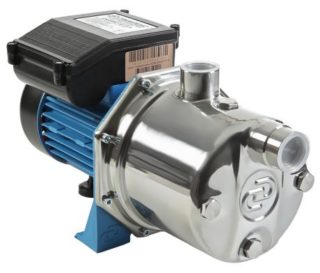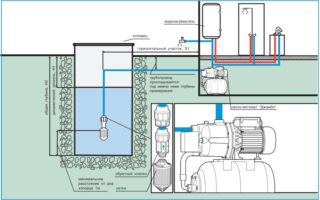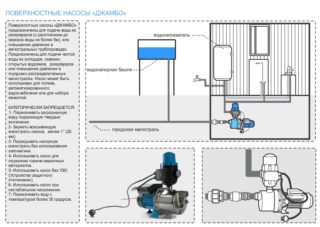For the device of an autonomous water supply system in suburban areas, they install their own sources (well, well). But from them you still need to transport the liquid to the point of use. This is where Jumbo Jilex surface pumps come to the rescue. A seemingly simple device can handle a large volume of water per unit of time.
Where can surface Jumbo pumps be used?
- high-quality watering of the garden plot;
- water supply to the house to all plumbing points.
To avoid strong vibration and noise of the operating unit, a rubberized mat can be laid under it.
Description and overview of models
For all models without exception, the following technical characteristics are the same:
- durable body material (polypropylene, stainless steel, cast iron, brass parts);
- durable plastic impeller;
- the presence of graphite-ceramic seals to prevent leaks;
- mounted aluminum adapter flange;
- the presence of an electric motor with a short-circuited system;
- installed thermal protector, which, if necessary, provides emergency blocking of the unit.

Several pump models are popular:
- Jumbo 60/35 P. Equipped with pressure switch and built-in ejector. In addition, there is a pressure gauge, a 24 liter carbon steel accumulator and all fittings. It turns out a full-fledged pumping station. The unit pumps 60 liters of water per minute at a pressure of 35 meters. It is permissible to pump media with impurities 0.8 mm in size. Power consumption 600 watts. The pump can be switched on up to 20 times per hour. Operating temperature range from +1 to +50 degrees. The pump can lift water from a depth of 9 meters. The device is additionally equipped with a cooling fan.
- Jumbo 70/50 N. Pumping station with a steel hydroaccumulator. The maximum volume of pumped water per hour is 70 liters. The head is 50 meters. The admissible suction depth is 9 meters. The pump consumes 1100 watts. The unit operates with water, the temperature of which varies from +1 to +50 degrees. The model is equipped with a pressure switch and a built-in ejector. The body is made of stainless steel.
- Jumbo 60/35 H. This model has a cast iron body. The pump is also equipped with a pressure switch, a pressure gauge and a 24-liter hydroaccumulator. The unit pumps 60 liters / min at a head of 35 meters. The pump can transport media with small impurities up to 0.8 mm. The depth of the liquid intake is 9 meters. Power consumption 600 watts. The maximum temperature of the pumped-over water is +50 degrees.
- Jumbo 60/35 N. The model completely repeats its predecessors 60/35 P and 60/35 H with the only difference that the pump body is made of stainless steel.
- Jumbo 70/50 P. Like previous models, it is equipped with a hydraulic tank, pressure switch, pressure gauge. The pump body is made of durable polymer. Otherwise, its technical characteristics are completely identical to the 70/50 H model with a stainless steel case.
- Jumbo 70/50 H. Capabilities of the pump fully coincide with models 70/50 N and 70/50 P. The only difference is that the product body is made of durable cast iron.
All units are equipped with a Venturi tube system, which improves the performance of the equipment.There are also modifications of Jumbo surface pumps with 50 liter hydraulic tanks.
Installation and operation

Correct installation of pumping equipment ensures its full operation without failures and breakdowns. Therefore, during installation work, it is important to provide for the following:
- It is advisable to install the pump on a specially prepared anti-vibration level platform. This will reduce the noise level of the operating equipment.
- If the pump will be used in winter, you need to arrange a special insulated caisson under it. Otherwise, the system will freeze. You also need to insulate water pipes from the source to the pump and to the house. You can install a pumping station in the basement of the cottage, provided that it is heated.
- If the pump will be mounted on brackets to the wall, it is also advisable to lay rubber gaskets under them so that the vibration of the unit does not violate the integrity of the walls.
Otherwise, the installation of the pump looks like this:
- From the water mirror plus the required number of meters inward, measure a piece of pipe that will reach the pump inlet.
- A coarse filter is put on the end of the tube, which will be immersed in the pumped medium. It will protect the working chamber of the unit from debris.
- A check valve is mounted on the pump inlet and then connected to the second end of the pipe. All joints are laid with FUM tape for better sealing.
- Another section of the pipe is pulled from the accumulator to the central line.
- After the station is completely assembled, it must be filled with water (including the tank). It is forbidden to run the pump dry.
- Before turning on the equipment, regulate the pressure in the system. It should be 2.6-3 atm. With such indicators, the pump will turn on and off independently.
- Once all the equipment is configured, it can be started from the network.
At the first start-up, check the pipeline and the station for leaks. If the pump will not be used in winter, it is necessary to drain all the water from the system and remove the unit to heat.
Advantages and disadvantages of Jumbo pumps
In addition to a wide range of models, Jumbo surface aggregates have a number of advantages:
- Increased functionality. With the help of a small unit, a continuous supply of water is provided for a family of 2-3 people.
- Smooth start. The equipment is insured against water hammer and too high starting currents, so it will work longer.
- Cooling fan acting as overheating protection.
- Easy to install and configure. Even a beginner can handle the equipment.
- Energy saving.
- Protection against possible voltage surges.
The only drawback of Jumbo surface pumps is their moderate performance. For a family of 4-5 people, such equipment as a pumping station will not be enough. The unit copes confidently with irrigation of the site.









